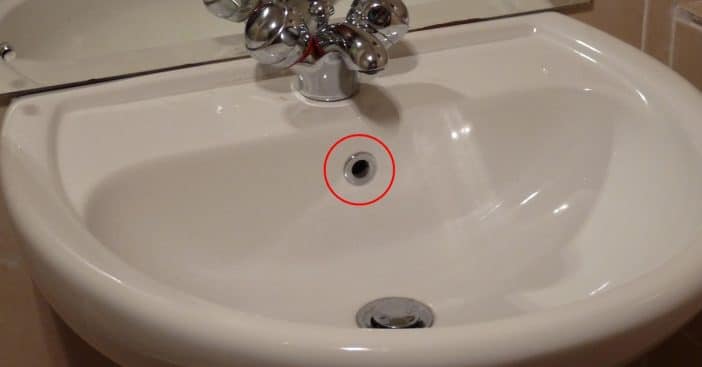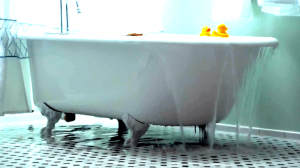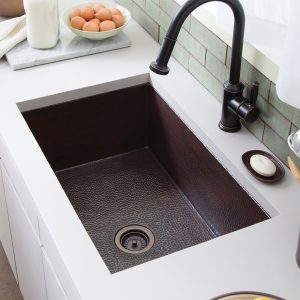
When you go to wash your hands or rinse a glass out, you may have noticed a hole – or three – on the upper part of the sink. This is in addition to the drain at the very bottom to easily empty the basin. If there’s already a perfectly functioning drain, why is there an extra hole in the sink? And why would it be higher up?
However many there are on the side, these holes actually have multiple purposes, all of which contribute to making a sink so easy and convenient to use. As with many important appliances, form fits function. Designers take into account the different ways various water basins are used, from kitchen sinks versus bathroom sinks to we fill bathtubs. There is also some physics rules that dictate how these are ultimately designed.
One purpose can really save your home

Sometimes, we need to fill the bathroom sink with water. Perhaps your hands need a nice soak in soapy warm water without all the fuss of a bath. Maybe some item needs to sit in warm water for a bit. Sometimes we make up sinks full of water and cleaning solution to wipe down a room. Whatever the reason, it is important to be able to fill our sinks. Thankfully, they have a drain that can be closed so we can do just that.
RELATED: How To Clean A Stainless Steel Sink More Effectively
Sometimes, though, we become distracted. Being at home doesn’t always mean the hustle and bustle of the outside world stops! It is a very relatable occurrence, but when it happens the resulting flood can be devastating. At best, there is a lot of water to soak up. At worst, it becomes a safety hazard and ruins that area of the home. For this reason, sinks are designed with an extra hole in the sink. This gives the water an additional way to escape, potentially avoiding a lot of grief.
We see this design elsewhere for similar reasons

Bathroom sinks are not the only place we see this design choice. Perhaps one of the most common – and notorious – locations for such a vent hole is the bathtub. It has a similar reason for being present here, and really reinforces how important it is to safeguard against disasters from distractions.
Bathtubs take time to fill. Quite a bit of time. It’s not uncommon to want to do other things while that giant basin fills up with luxurious, warm water. The buildup, though, is akin to watching paint dry, only with a bit more humidity. If a tub overflows, the results can be a lot more costly than if the sink does. Both are important to protect from overflow, and so both share this important design feature. From personal experience, I’m very thankful for this small but important safeguard!
That extra hole in the sink serves another purpose
Some interesting rules of science and airflow come into play when considering that overflow vent hole. We can see the reason for its presence in other household tasks. Have you ever dispensed laundry detergent from one of those large containers, and noticed it pours out from the pump better when you remove the top cap? That’s because it has airflow above the surface of the liquid.
Similarly, that extra hole in the sink helps water flow – not out of a pump but down the drain. Without that hole there, there is actually a lot of resistance from the air trying to escape the drain, and as a result, the water drains from the basin especially slowly. This hole offers an escape route for the air so a sink can drain faster.
These helpful little features are absent from kitchen sinks for an important reason

Bathroom sinks and tubs have vent overflow holes, but why don’t kitchen sinks have them? This is actually because of a hygiene concern. Little nooks and crannies like those extra sink holes are prime areas for bacteria to grow in. It’s dangerous to have food in such close proximity to bacteria that are actively thriving in an important space like the kitchen. They would have easy access not only to food but also to utensils, drinking water, and glassware.
If you detect a strong odor from basins that do have an extra hole in the sink, that is a sign it needs to be cleaned. Across generations, new tricks to maintaining the house arise. In this case, though, it is generally recommended to use a good narrow brush, septic-safe enzymatic drain cleaner, and hot water. It’s worth keeping up with this because the alternatives can be pretty scary!

RELATED: How To Clean Your Keurig To Avoid Mold And Bacteria
FAQS
What is the extra hole in the sink for?
The name “overflow hole” is quite fitting, as its purpose is to prevent your sink from flooding. It accomplishes this by redirecting the water flow, providing you with additional time to react in case you or someone in your home inadvertently leaves the faucet running or encounters a plumbing problem.
How does the hole in the sink work?
The overflow hole exists to divert excess water, allowing you to act before the water starts to spill over. This ingenious feature ensures that the sink’s contents won’t spill over uncontrollably.
What is the overflow hole in a sink called?
The sink overflow hole is simply called the overflow hole. It’s an opening that directs the water into the sink overflow system.
